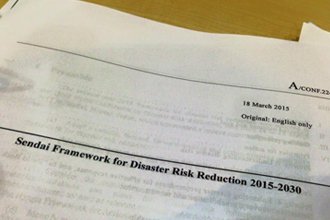 |
he Sendai Framework is a 15-year, voluntary, non-binding agreement which recognizes that the State has the primary role to reduce disaster risk but that responsibility should be shared with other stakeholders including local government, the private sector and other stakeholders. It aims for the following outcome:
The substantial reduction of disaster risk and losses in lives, livelihoods and health and in the economic, physical, social, cultural and environmental assets of persons, businesses, communities and countries.
The Sendai Framework is the successor instrument to the Hyogo Framework for Action (HFA) 2005-2015: Building the Resilience of Nations and Communities to Disasters. It is the outcome of stakeholder consultations initiated in March 2012 and inter-governmental negotiations held from July 2014 to March 2015, which were supported by the UNISDR upon the request of the UN General Assembly.
UNISDR has been tasked to support the implementation, follow-up and review of the Sendai Framework.
Download Chart of the Sendai Framework
The Seven Global Targets
(a) Substantially reduce global disaster mortality by 2030, aiming to lower average per 100,000 global mortality rate in the decade 2020-2030 compared to the period 2005-2015.
(b) Substantially reduce the number of affected people globally by 2030, aiming to lower average global figure per 100,000 in the decade 2020 -2030 compared to the period 2005-2015.
(c) Reduce direct disaster economic loss in relation to global gross domestic product (GDP) by 2030.
(d) Substantially reduce disaster damage to critical infrastructure and disruption of basic services, among them health and educational facilities, including through developing their resilience by 2030.
(e) Substantially increase the number of countries with national and local disaster risk reduction strategies by 2020.
(f) Substantially enhance international cooperation to developing countries through adequate and sustainable support to complement their national actions for implementation of this Framework by 2030.
(g) Substantially increase the availability of and access to multi-hazard early warning systems and disaster risk information and assessments to the people by 2030.
The Four Priorities for Action
Priority 1. Understanding disaster risk
Disaster risk management should be based on an understanding of disaster risk in all its dimensions of vulnerability, capacity, exposure of persons and assets, hazard characteristics and the environment. Such knowledge can be used for risk assessment, prevention, mitigation, preparedness and response.
Priority 2. Strengthening disaster risk governance to manage disaster risk
Disaster risk governance at the national, regional and global levels is very important for prevention, mitigation, preparedness, response, recovery, and rehabilitation. It fosters collaboration and partnership.
Priority 3. Investing in disaster risk reduction for resilience
Public and private investment in disaster risk prevention and reduction through structural and non-structural measures are essential to enhance the economic, social, health and cultural resilience of persons, communities, countries and their assets, as well as the environment.
Priority 4. Enhancing disaster preparedness for effective response and to “Build Back Better” in recovery, rehabilitation and reconstruction
The growth of disaster risk means there is a need to strengthen disaster preparedness for response, take action in anticipation of events, and ensure capacities are in place for effective response and recovery at all levels. The recovery, rehabilitation and reconstruction phase is a critical opportunity to build back better, including through integrating disaster risk reduction into development measures.
Implementation guides for the Sendai Framework
The Sendai Framework for Disaster Risk Reduction charts the global course over the next 15 years. During the consultations and negotiations that led to its finalization, strong calls were made to develop practical guidance to support implementation, ensure engagement and ownership of action by all stakeholders, and strengthen accountability in disaster risk reduction.
Paragraph 48 (c) of the Sendai Framework calls upon “the United Nations Office for Disaster Risk Reduction (UNISDR), in particular, to support the implementation, follow-up and review of this framework through […] generating evidence-based and practical guidance for implementation in close collaboration with States, and through mobilization of experts; reinforcing a culture of prevention in relevant stakeholders […]”. In order to support the process, a number of targeted Sendai Framework implementation guides shall be developed.